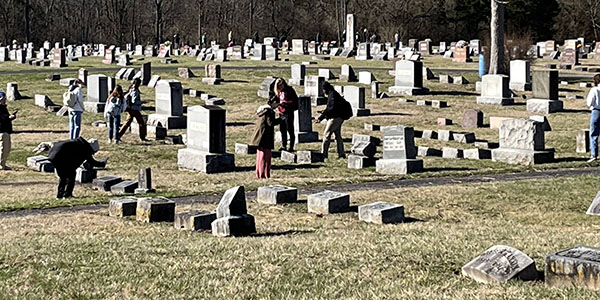Miami GIS students perform a ‘major role’ for Oxford community
Project to map Oxford Cemetery gives students real-world experience

Miami GIS students perform a ‘major role’ for Oxford community
When Robbyn Abbitt’s Advanced Geographic Information Systems (GIS) students started work on mapping Oxford Cemetery in fall 2023, they were given a high resolution drone image of the cemetery, as well as a stack of paper maps to work with, some of which included roads that no longer exist.
By the time spring semester wrapped up, 54 of Abbitt’s students had located more than 6,300 headstones, worked 500-plus hours, and digitally created a valuable source of information for their community.
The collaboration with the city of Oxford has already produced dividends, said Mike Green, grounds maintenance supervisor for the cemeteries. For Memorial Day, Green and a group of volunteers used the information generated by Miami students to lay flags on the plots of veterans.
By scanning a QR code, they were taken to the Oxford Cemetery Digital Resources website that not only provides access to veteran gravestones but also includes several other resources, including a gravefinder and stories of many of those interred in Oxford Cemetery, located just past Peffer Park on Highway 27.
“That was very beneficial for us,” Green said. “Being able to see those points on our phones helped out tremendously and sped things up.”
Abbitt and Miami became involved in the project after the city of Oxford inherited the cemetery in January 2022 from the Oxford Cemetery Association. Abbitt’s classes had done similar work previously with local cemeteries, including in Milford Township and Preble County.
Oxford Cemetery was established in 1855.
“It is a fantastic way to bring outside work into the classroom,” said Abbitt, GIS Coordinator and Associate Director of Miami’s Geospatial Analysis Center.
Work began for Abbitt’s 29 fall semester students by reading peer reviewed literature and trade magazines to become familiar with methodology and the mapping process.
Those students also built the database structure and did a first run at collecting data prior to handing the project off to 25 students in the spring semester.
Using the interment cards, Abbitt’s spring students collected additional data and provided guidance on how the city might be able to use georeferencing in the future.
Preston Lawson, a rising senior from Ross majoring in Biology and earning a certificate in Geographic Information Science, worked on the project during the spring semester. Lawson and classmates did quality assurance and quality control, double-checking the data provided by the fall semester students.
After dividing the cemetery into quadrants, or “fishnets,” each student took a set number of headstones to fact check.
“With some of the headstones, it was kind of a race against time,” Lawson said, noting some of the headstones were weathered and information could be spotty.
“It was really interesting getting a look at their life stories.”
Many of those stories are featured in the Oxford Cemetery resources hub, which includes sections on specific families, as well as “the Unsung Heroes of Oxford Cemetery,” “Oxford Cemetery: Telling the Miami Story,” and more.
“There are so many interesting stories out there in the cemetery,” Abbitt said. “The students really connected with last names that they see on buildings on campus and street names in town. I was surprised by how connected to the community the students felt at the end of each semester.
“Every headstone out there is a story. They really felt like they were taking ownership and allowing those stories to be told.”
That, Green said, was another benefit of the project, aside from having an easily accessible overview and layout of the cemetery.
“The students, when they came to Oxford, they probably had no idea they’d be doing this type of work for the community,” Green said. “It’s nice they can feel they have ties and investment to the place they came for their higher education.
“This was a major undertaking. They were able to perform a major role for this community.”
The real-world application of the project was important, Lawson said.
“I never really thought of how universities in general work their local communities,” Lawson said. “This was a really good project that impacted a community, rather than staying on campus and keeping our heads down sort of thing.”